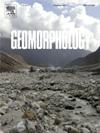Detrital zircon geochronology of river sands from the Salween River: Implications for sedimentary provenance and erosion pattern
IF 3.1
2区 地球科学
Q2 GEOGRAPHY, PHYSICAL
引用次数: 0
Abstract
Erosion patterns are generally controlled by the interaction of internal tectonic forces and external surface process, including active tectonic processes, precipitation, hillslope steepness and human activities. Studying sediments in river systems helps us understand watershed erosion, contributing to our comprehension of landform evolution, climate change, and biodiversity. The Salween River is a significant international river in Asia, less disturbed by human activities than other large rivers such as the Yangtze River. In this study, we use zircon U-Pb dating and Hf isotopes of bedrocks and mainstream river sediment to reveal the relative sediment contribution of bedrock in the Salween River. The detrital zircon U-Pb ages and combined Hf isotopic data from the Salween River suggest that bedrocks from the middle section of the river contribute a large amount of sediments to the Salween River. This indicates that the middle section of the Salween River has been experiencing intense erosion. Potential impact factors such as human activities, climate, slope, lithology, and tectonism that may control distribution of erosion are considered. We suggest that the most important factor controlling intense erosion in the middle section of the Salween River is likely to be the hillslope steepness. We also suggest that the characteristic zircon U-Pb age distributions of the Salween River could be used to reconstruct paleo-drainage patterns in the southeastern Tibetan Plateau.
萨尔温江河沙的碎屑锆石地质年代学:对沉积来源和侵蚀模式的影响
本文章由计算机程序翻译,如有差异,请以英文原文为准。
求助全文
约1分钟内获得全文
求助全文
来源期刊

Geomorphology
地学-地球科学综合
CiteScore
8.00
自引率
10.30%
发文量
309
审稿时长
3.4 months
期刊介绍:
Our journal''s scope includes geomorphic themes of: tectonics and regional structure; glacial processes and landforms; fluvial sequences, Quaternary environmental change and dating; fluvial processes and landforms; mass movement, slopes and periglacial processes; hillslopes and soil erosion; weathering, karst and soils; aeolian processes and landforms, coastal dunes and arid environments; coastal and marine processes, estuaries and lakes; modelling, theoretical and quantitative geomorphology; DEM, GIS and remote sensing methods and applications; hazards, applied and planetary geomorphology; and volcanics.
 求助内容:
求助内容: 应助结果提醒方式:
应助结果提醒方式:


